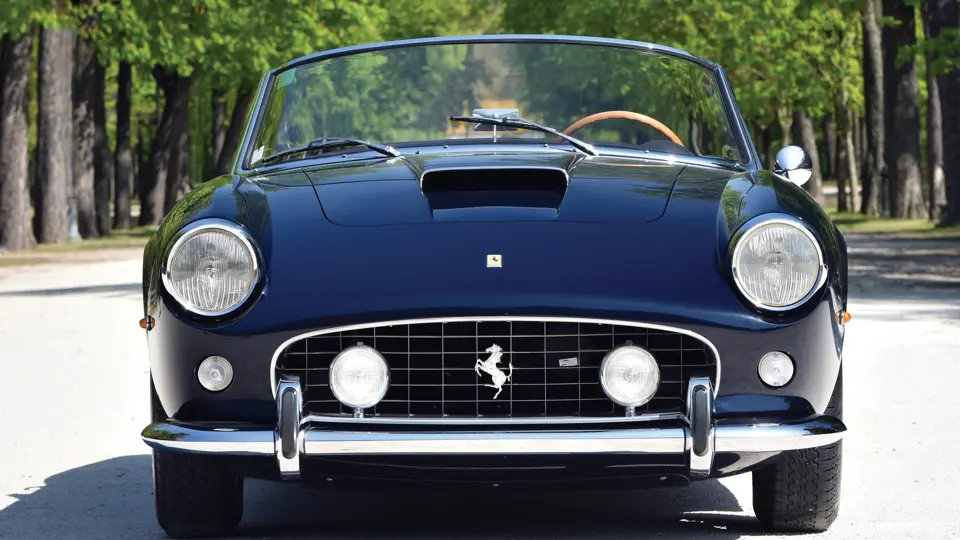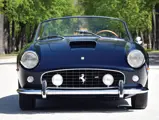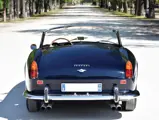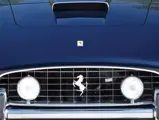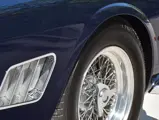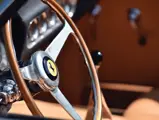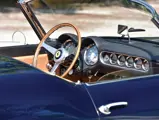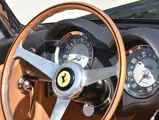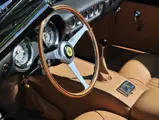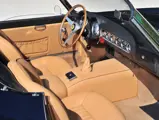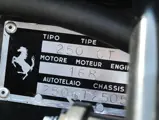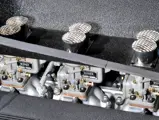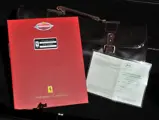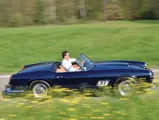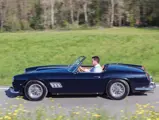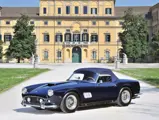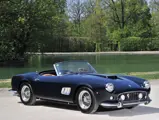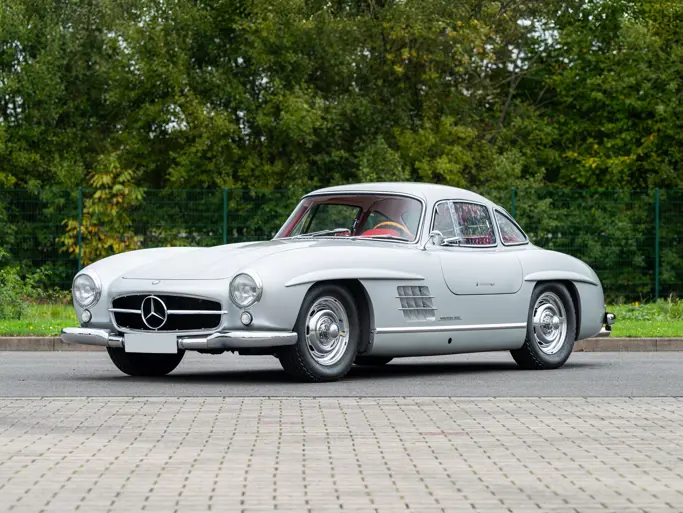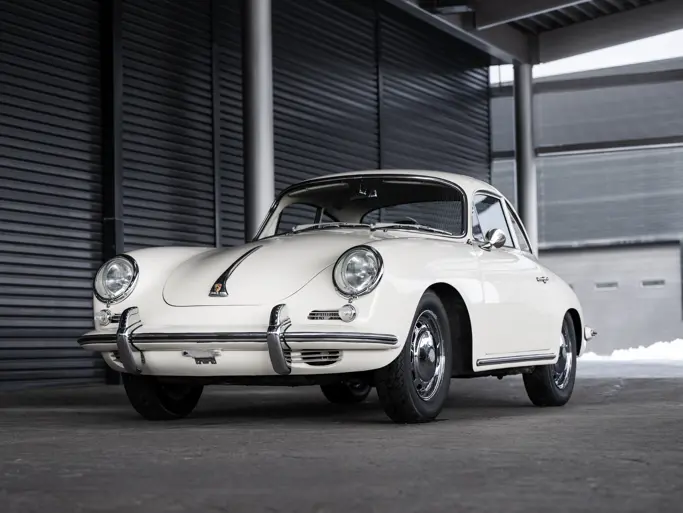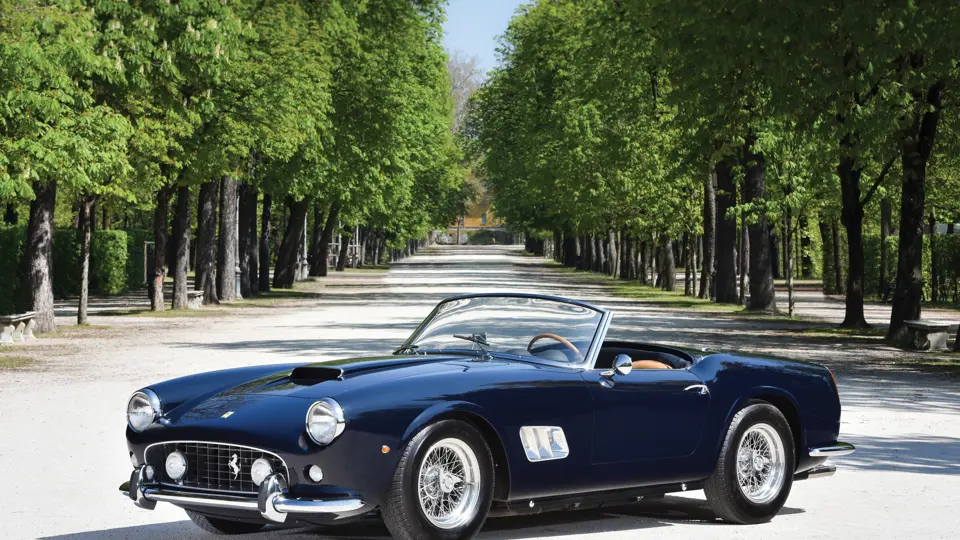
1961 Ferrari 250 GT SWB California Spider by Scaglietti
{{lr.item.text}}
€11,000,000 - €13,000,000 EUR | Not Sold
{{bidding.lot.reserveStatusFormatted}}
- One of 16 open-headlight SWB California Spiders
- Fully restored and certified by Ferrari Classiche
- Displayed at the Museo Ferrari
- Winner of the Ferrari Classiche Cup and the 2011 Cavallino Classic
- Displayed at the 2013 Concourso d’Eleganza Villa d’Este
- The quintessential open-air sporting Ferrari
- Una delle 16 California Spider passo corto in versione Italiana
- Completamente restaurata e certificata dalla Ferrari Classiche
- Esposta al Museo Ferrari
- Vincitrice della Ferrari Classiche Cup e del Cavallino Classic 2011
- Esposta all'edizione 2013 del Concorso d'Eleganza di Villa d'Este
- La Ferrari Spider per eccellenza
226 bhp, 2,953 cc SOHC Colombo V-12 engine with three Weber 40 DCL6 carburettors, four-speed manual transmission, independent front suspension with parallel A-arms and coil springs, solid rear axle with semi-elliptical leaf springs, and four-wheel Dunlop disc brakes. Wheelbase: 2,400 mm
280 cv, motore Colombo V-12 da 2.953 cc con tre carburatori Weber 40 DCL6, trasmissione manuale a quattro velocità, sospensioni anteriori indipendenti a triangoli paralleli e molle elicoidali e posteriori a ponte rigido con balestre semi ellittiche e freni a disco Dunlop su tutte e quattro le ruote. Passo 2.400 mm
LA DOLCE VITA
For most motoring enthusiasts just mentioning the words “California Spider” stir up emotions of la dolce vita and the finest motoring experience that one can imagine. The car featured incredible drop-top styling by Pininfarina and Scaglietti, a sumptuous Colombo 3.0-litre V-12 engine, space for two plus their luggage, and race-bred performance, and it was adorned with a Prancing Horse on the front—what could be better?
In the late 1950s, Luigi Chinetti and John von Neumann, Ferrari’s two U.S. distributors, both realised that a convertible version of the 250 GT Berlinetta Tour de France would sell well in the United States, as clients desired the performance of the TdF yet yearned for the excitement that a convertible provided. The California Spider proved to be a success, and as Ferrari updated the 250 GT Berlinetta to ensure that it remained competitive in motorsport, it was only natural that the California Spider received a similar set of upgrades.
The biggest difference between the original California Spider and the newer series that had first been shown at the Geneva Salon in March 1960 was the change in wheelbase. In an effort to improve handling and increase the car’s cornering speeds, the wheelbase was reduced from 2,600 millimetres to 2,400 millimetres. Through utilising the newer Tipo 168 design with new heads and larger valves, the engine was now reported to produce up to 280 horsepower. Additionally, the track was wider than that of the outgoing California Spider, and the car’s lever-type shock absorbers were replaced with newer Koni adjustable and telescopic shock absorbers. Braking was transformed by the inclusion of four-wheel Dunlop disc brakes, and the SWB California Spider became the contemporary of the legendary 250 SWB Berlinetta.
In 1961, a gentleman driver could drive his California Spider to the race track, easily outrun comparable Aston Martins and Jaguars, and drive home again in the early evening with the top-down and in utmost comfort. The car’s dual-purpose nature appealed to many well-heeled individuals, and SWB California Spiders were owned by film stars, such as Alain Delon, James Coburn, and Roger Vadim; European aristocracy, including Vittorio Emanuele of Savoy; and even racing drivers. Jan De Vroom campaigned his SWB California Spider at both the 1960 24 Hours of Le Mans and the 1961 12 Hours of Sebring, where he finished 12th overall, which is an incredible result for a street-legal convertible.
CHASSIS NUMBER 2505 GT: A EUROPEAN SPIDER
Whilst the majority of California Spiders were delivered new to the United States, a handful of cars remained in Europe, and such was the case with chassis 2505 GT. The chassis was completed in February 1961 and by 22 July of that year, its engine had been built, tested on the dyno, and the car passed on its first run. The car was completed by the factory on 25 July 1961 and finished in Grigio Conchiglia (16249 M) over a Pelle Blue (VM 3087) interior. It was the 18th of a grand total of 56 SWB California Spiders built, but just the fourth of sixteen examples finished with open headlights. According to the factory build sheet, the car was fitted with Pirelli tyres and an 8x32 rear axle with a limited slip differential upon delivery.
According to the red Ferrari certification binder that accompanies the car, it was delivered new to Gastone Crepaldi S.a.S., the official Ferrari dealership in Milan, Italy. The 250 GT was then sold by Crepaldi to its first private owner later that year. By the late 1960s, the car was residing in Rome and had been refinished in classic Ferrari red over a beige interior.
Chassis 2505 GT remained in Italy until 1974, when it was purchased by Karl Mösch, of Uitikon-Waldegg, a suburb of Zürich, Switzerland. Mösch would go on to own the car for over 20 years, and he used it in various events with the Bugatti-Ferrari Owners Club Switzerland throughout his tenure. In 1997, the car was sold to a well-known collector in the UK, and later that year, it was sold again to Karl-Gustav Diederichs, of Remscheild, Germany. In his ownership, the car was restored by Uwe Messiner’s Modena Motorsport Ltd., of Langenfeld, Germany. Diederichs continued to use the car in the same fashion as Mösch. For the next few years, the Ferrari was seen at a handful of events in Germany and Italy, including at Villa d’Este in 2004.
In 2007, shortly after its acquisition by its current owner, chassis number 2505 GT returned to Ferrari’s facilities in Maranello, where it was subjected to a complete restoration by Ferrari Classiche. During the restoration, all mechanical systems were fully re-built and it was refinished in the stylish shade of Blu Scuro over a Pelle Beige interior. At the same time, the car also received Ferrari Classiche certification, confirming that it is fully matching numbers and correct throughout. As one would expect, the standard of the restoration, the correctness of the finishes, and the panel fit are second to none, making this one of the very finest and most authentic examples of the model in the world.
Following the completion of the restoration in 2010, the California Spider’s first concours outing was at the Ferrari Challenge World Finals in Valencia in 2010, where it was driven on the parade lap by none other than Ferrari President Luca di Montezemolo. Following this, it was shown at the Cavallino Classic in January 2011. The car’s breath-taking restoration was clearly very well-received by the judges, as it received a Platinum award and won the coveted Ferrari Classiche Cup for being the finest Classiche-certified Ferrari entered for judging. It also received a Mention of Honour at the 2013 Concorso d’Eleganza Villa d’Este. Beginning in April 2014, chassis number 2505 GT was displayed at the Museo Ferrari in Maranello as a part of the California Dreaming exhibition, which celebrated Ferrari’s 60 years of history in the United States.
As the most celebrated open-air Ferrari ever made, the 250 GT SWB California Spider is an automobile with few peers. Ownership of such an automobile, both now and when new, is something that almost every Ferrari enthusiast aspires to yet something that few can attain. It is the epitome of la dolce vita in the automotive world, as it combines timeless style with incredible performance, and it is an automobile equally capable of pleasing its owner on the open road, the race track, or both in a single day.
Chassis number 2505 GT remains ready and eligible for display at all of the world’s most prestigious concours events, where it would be welcomed with open arms. As a European-delivery example with open headlights, 2505 GT is a rare sight in the realm of SWB California Spiders, and it is truly stunning to behold. It is accompanied by a full set of tools, as well as ASI and FIVA documentation, and has received a restoration and full certification by Ferrari Classiche. This car drives beautifully, looks absolutely spectacular, and is ready to delight its next owner.
It would be an excellent choice for an open-air jaunt to Portofino for the weekend.
LA DOLCE VITA
Per molti appassionati, il solo sentire le parole "California Spider" fa venire in mente le emozioni della dolce vita e porta a sognare una delle migliori esperienze di guida in assoluto. L'auto era caratterizzata dalla carrozzeria aperta disegnata da Pininfarina e costruita da Scaglietti, da un meraviglioso motore Colombo V-12 da 3 litri, da uno spazio per due più i bagagli e da prestazioni da auto da corsa e il tutto adornato dal Cavallino Rampante sulla calandra. Cosa si può chiedere di più?
Verso la fine degli anni '50, Luigi Chinetti e John von Neumann, i due distributori americani per la Ferrari, intuirono che una versione cabriolet della 250 GT Berlinetta Tour de France avrebbe avuto un gran successo negli Stati Uniti. Infatti i clienti desideravano le prestazioni della TdF, ma desideravano anche poter provare l'emozione che solo un auto scoperta può dare. La California Spider si rivelò un successo e quando la Ferrari aggiornò la 250 GT Berlinetta affinché rimanesse competitiva nelle corse, fu naturale che la California Spider ricevette delle modifiche simili.
La maggior differenza fra la California Spider originale e la serie più recente presentata al Salone di Ginevra nel marzo 1960 era il cambio del passo. Per migliorare la maneggevolezza ed incrementare la velocità in curva dell'auto, il telaio era stato portato da 2.600 mm a 2.400 mm. Aggiornando anche il nuovo motore Tipo 168 con nuove testate e valvole più grandi era stato possibile portare la potenza fino a 280 cavalli. Inoltre la carreggiata era più larga rispetto alla versione precedente della California Spider e gli ammortizzatori idraulici furono sostituiti dai più nuovi, telescopici e regolabili Koni. La frenata fu migliorata grazie all'adozione di quattro freni a disco Dunlop, facendo diventare la 250 California passo corto come la contemporanea 250 GT Berlinetta passo corto.
Nel 1961 un gentleman driver poteva guidare la sua California Spider al circuito, passare velocemente le comparabili Aston Martin, Jaguar e tornare a casa all'imbrunire con il tetto abbassato in assoluto comfort. La natura versatile dell'auto attraeva molti individui facoltosi e le Spider California appartenevano a stelle del cinema come Alain Delon, James Coburn e Roger Vadim. Queste auto appartenevano anche all'aristocrazia europea ( incluso Vittorio Emanuele di Savoia) ed anche a dei piloti. Jan De Vroom condusse la sua California Spider sia alla 24 ore di Le Mans del 1960 che alla 12 Ore di Sebring nel 1961, finendo 12esimo assoluto, il che costituisce un incredibile risultato per una cabriolet omologata per la strada.
IL NUMERO DI TELAIO 2505 GT: UNA SPIDER EUROPEA
Sebbene la maggior parte delle California Spider furono consegnate negli Stati Uniti, un esiguo numero di macchine rimase in Europa, come nel caso del telaio 2505 GT. Lo chassis fu completato nel Febbraio 1961 e il 22 luglio dello stesso anno, il suo motore fu ultimato, testato al banco e deliberato dopo il primo rodaggio. La macchina fu ultimata dalla fabbrica il 25 luglio 1961 e rifinita in Grigio Conchiglia (16249 M) con gli interni in pelle blu (VM3087). Fu la 19esima del totale di 56 California Spider passo corto costruiti e la quarta dei sedici esemplari ultimati con i fari aperti. Secondo il foglio di identificazione della fabbrica, la macchina era equipaggiata con gomme Pirelli e un differenziale autobloccante con rapporto 8x32.
Stando alla certificazione Ferrari Classiche, la macchina fu consegnata nuova a Gastone Crepaldi S.a.S., il distributore ufficiale Ferrari a Milano. Sempre nello stesso anno, questa 250 GT fu poi venduta da Crepaldi al suo primo proprietario. Alla fine degli anni 1960, la macchina era situata a Roma ed era stata riverniciata nel classico colore rosso Ferrari e l' interno cambiato in beige.
Il telaio 2505 GT rimase in Italia fino al 1974, quando fu acquistato da Karl Mosch, di Uitikon-Waldegg, un sobborgo di Zurigo, Svizzera. Mosch tenne l'auto per 20 anni e la usò per vari eventi anche con il Bugatti-Ferrari Owners Club Switzerlad. Nel 1997 la macchina fu venduta a Karl-Gustav Diederichs di Remscheild, Germania. Durante il periodo di sua proprietà, la macchina fu restaurata dalla Modena Motorsport Ltd di Uwe Messiner, Langeneld, Germania. Diederichs continuò ad usare la macchina esattamente come Mosch. Per i successivi anni questa Ferrari fu vista presso diversi eventi in Germana e in Italia, inclusa Villa d'Este nel 2004.
Nel 2007, poco dopo l'acquisto del suo attuale proprietario, il numero di telaio 2505 GT ritornò nella Fabbrica Ferrari, dove fu sottoposto ad un restauro totale da parte di Ferrari Classiche. Durante questo restauro, si revisionarono tutte le parti meccaniche e fu rifinita nell'elegante colore Blu Scuro con un interno in Pelle Beige. Contemporaneamente l'auto ricevette la certificazione Ferrari Classiche, confermando la corrispondenza fra numero di telaio e motore e l'assoluta originalità. Ovviamente la qualità del restauro, le giuste finiture e l'eccezionale lavoro sulla carrozzeria specialmente l’aggiustamento dei panelli sulla scocca, le arie tra le porte o cofani e carrozzeria, la qualita’ della verniciatura e delle cromature, rendendo quest'auto una delle migliori e più autentiche al mondo.
In seguito al completamento del restauro nel 2010, la prima presenza nei concorsi di questa California Spider fu alla Ferrari Challenge World Finals a Valencia nel 2010, dove fu guidata nel giro d'onore dall’allora Presidente della Ferrari Luca di Montezemolo. Successivamente, fu esibita al Cavallino Classic nel gennaio 2011. Il restauro mozzafiato valse il riconoscimento dei giudici della Ferrari Classiche Cup come la migliore Ferrari Classiche certificata iscritta al concorso. Inoltre ricevette una menzione d'onore all'edizione 2013 del Concorso d'Eleganza di Villa d'Este. All'inizio di aprile 2014, il numero di telaio 2505 GT fu esposto al Museo Ferrari di Maranello, come parte dell'esibizione California Dreaming, che celebrò i 60 anni di storia del Cavallino negli Stati Uniti.
Essendo la più celebrata Ferrari decapottabile, la 250 California Spider passo corto è un'automobile con pochi eguali. Il possesso di un auto simile, sia ora che quando era nuova, è un sogno di tutti gli appassionati Ferrari, anche se purtroppo è accessibile solo a pochi. Quest'auto è la personificazione della Dolce Vita del mondo delle auto; combina uno stile senza tempo con prestazioni incredibili ed è un'automobile ugualmente capace di regalare al suo proprietario emozioni sia sulle strade pubbliche che su circuito, o entrambe in una sola giornata.
Il numero di telaio 2505 GT rimane pronto ed idoneo per partecipare agli eventi più prestigiosi del mondo, dove sarà sempre accolto a braccia aperte. Essendo un esemplare italiano con fari aperti, la 2505 GT è un raro spettacolo nel reame delle California Spider ed è mozzafiato solo alla vista. L'auto è fornita da un set completo di attrezzi, così come documentazione ASI e FIVA e come la Certificazione Ferrari Classiche, con il book che ne attesta il restauro. Quest'auto ha un bellissimo comportamento su strada, è uno spettacolo per gli occhi ed è pronta ad emozionare il suo prossimo proprietario.
Sara’ la scelta perfetta per un bel week end a Portofino.

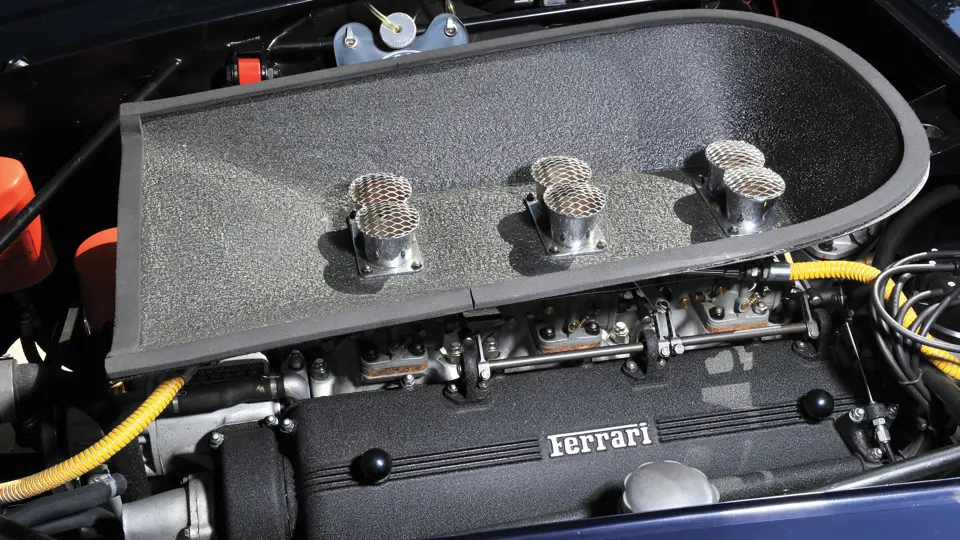
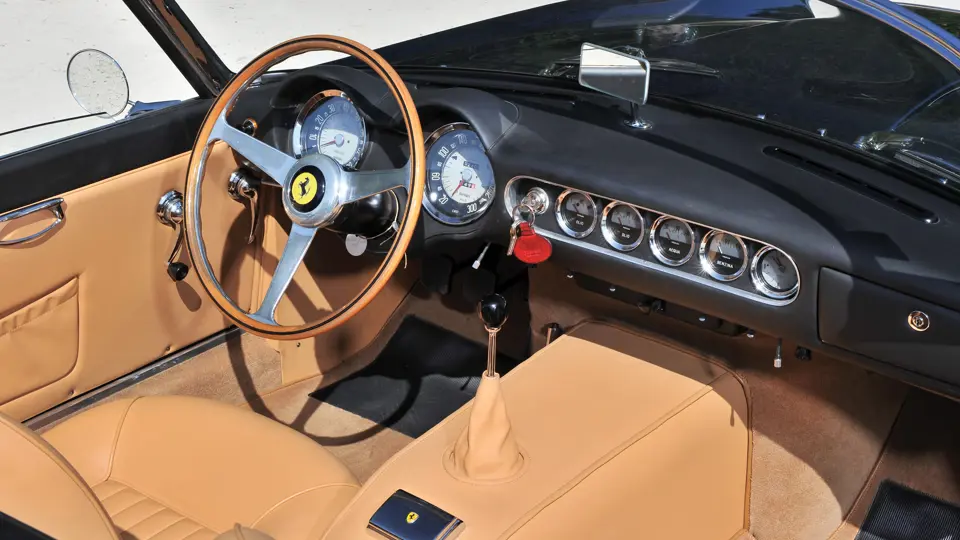


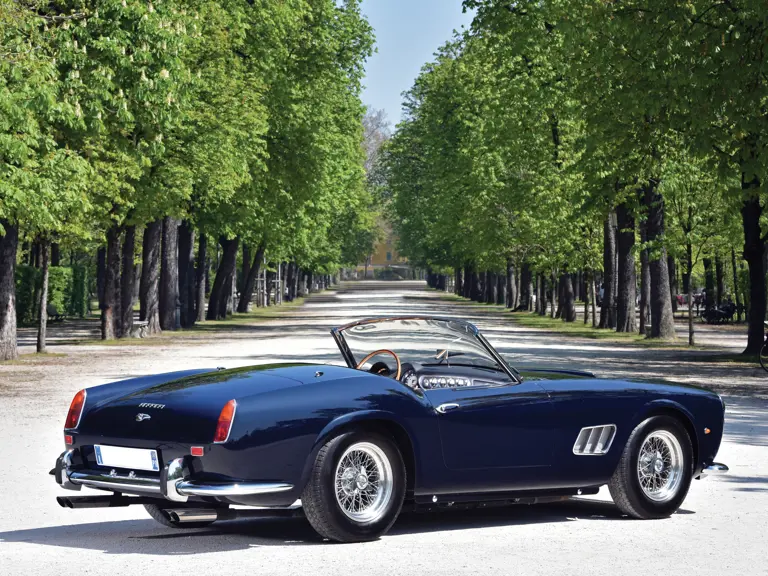
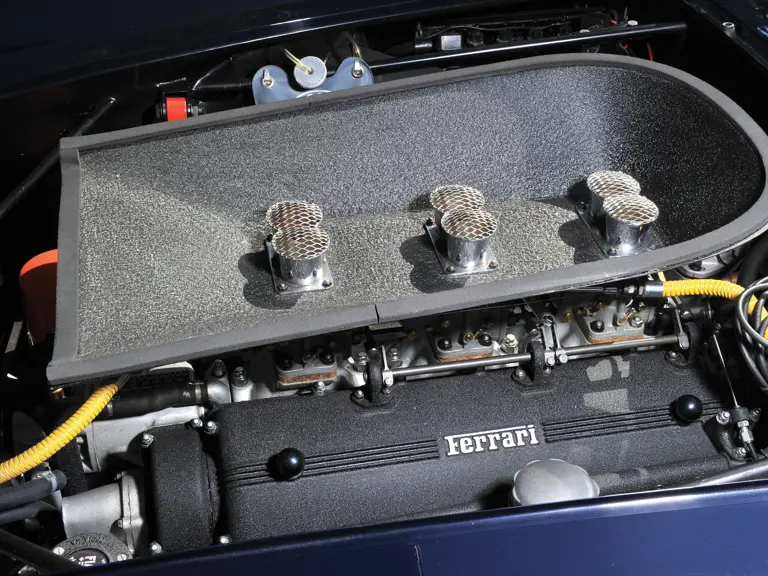
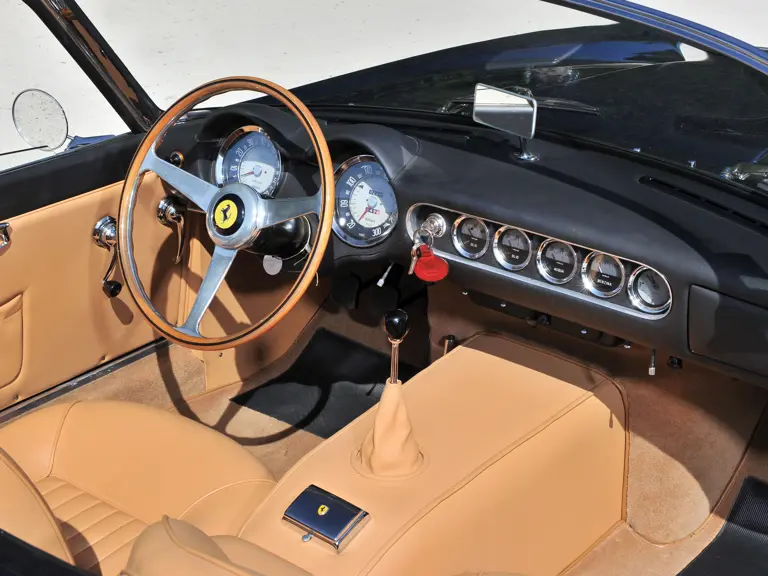
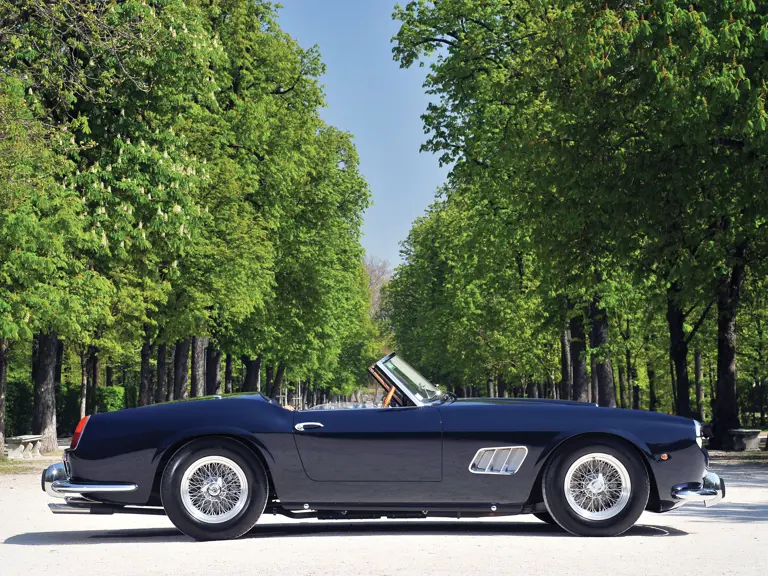

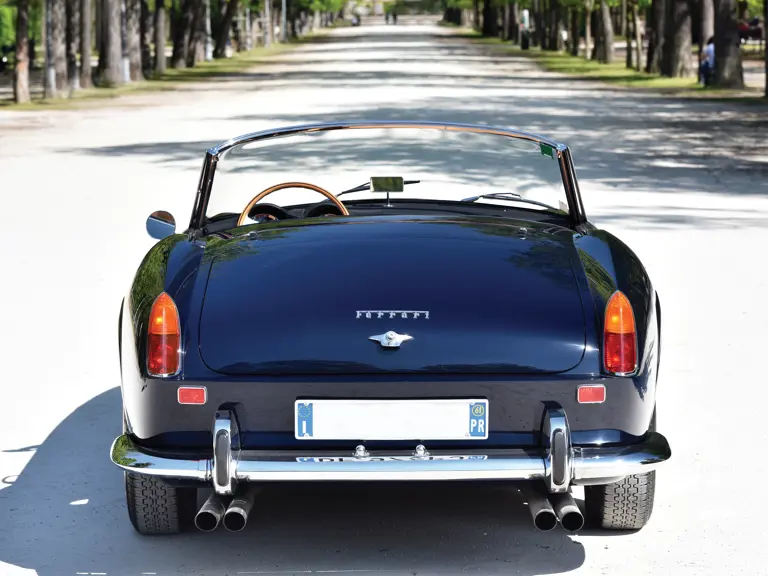
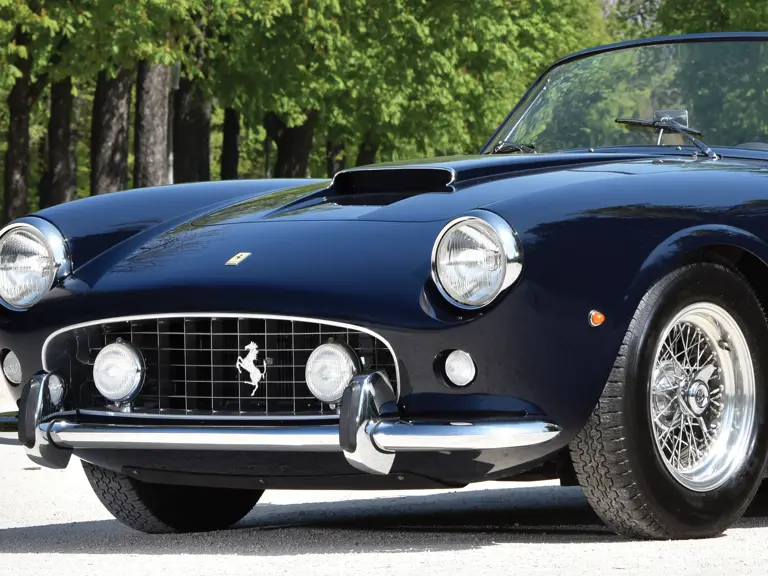

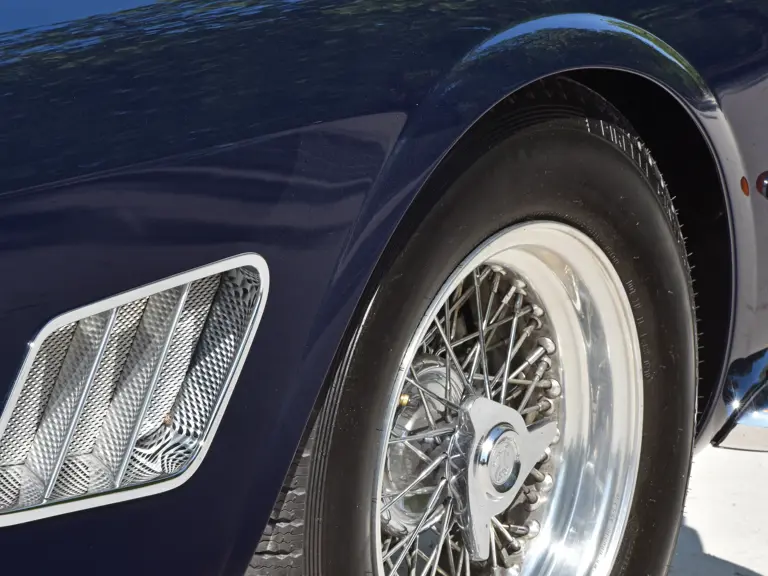

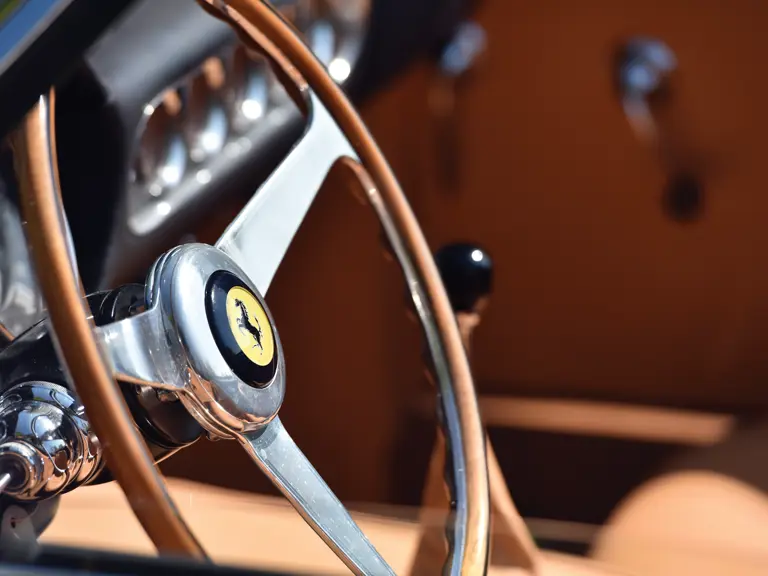

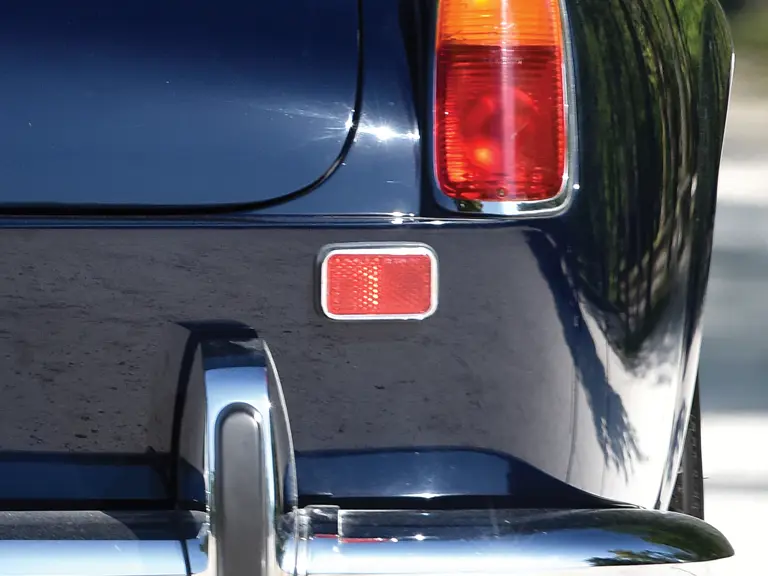
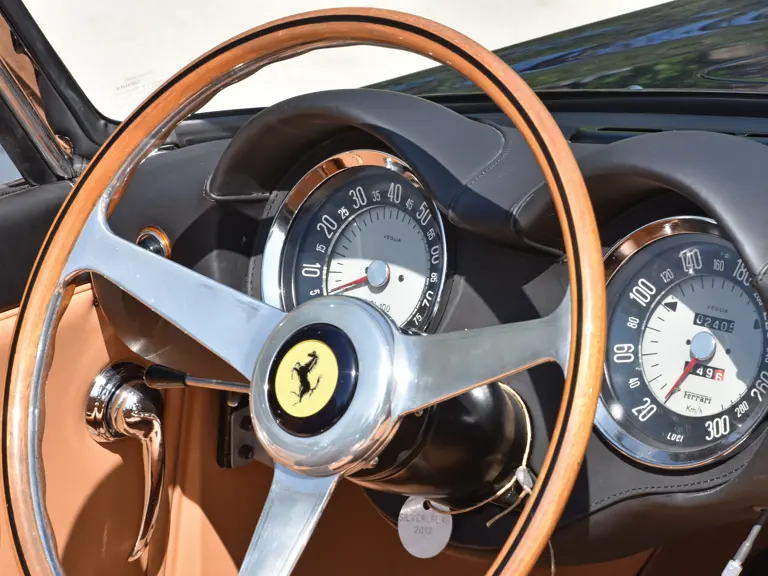
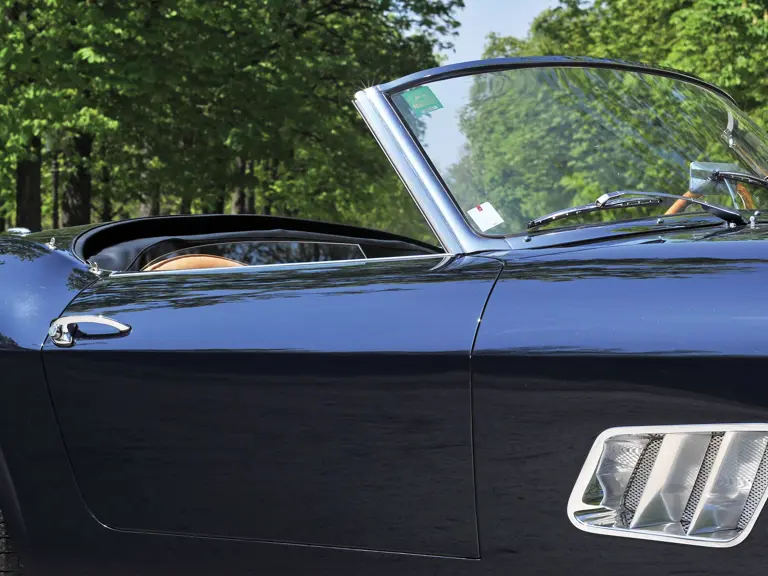
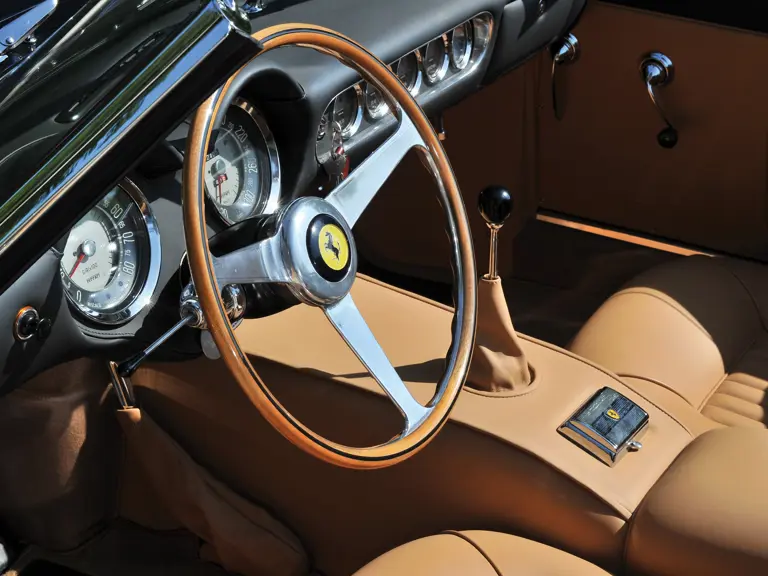

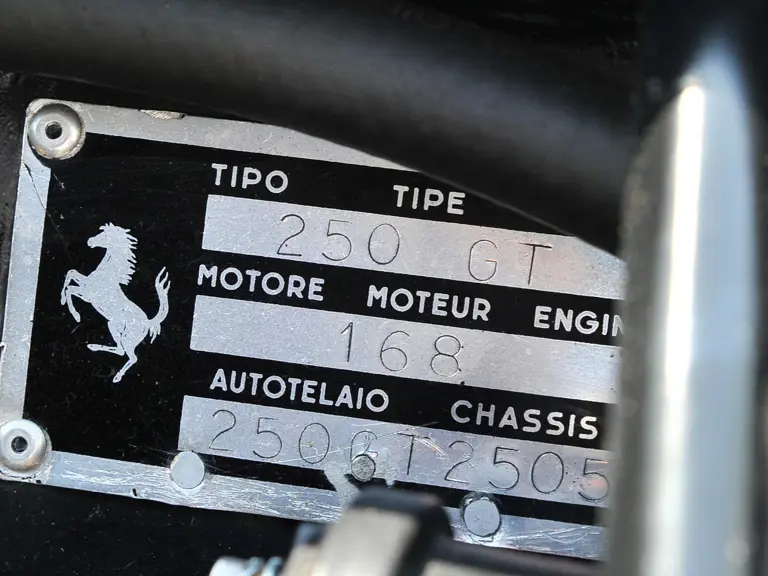



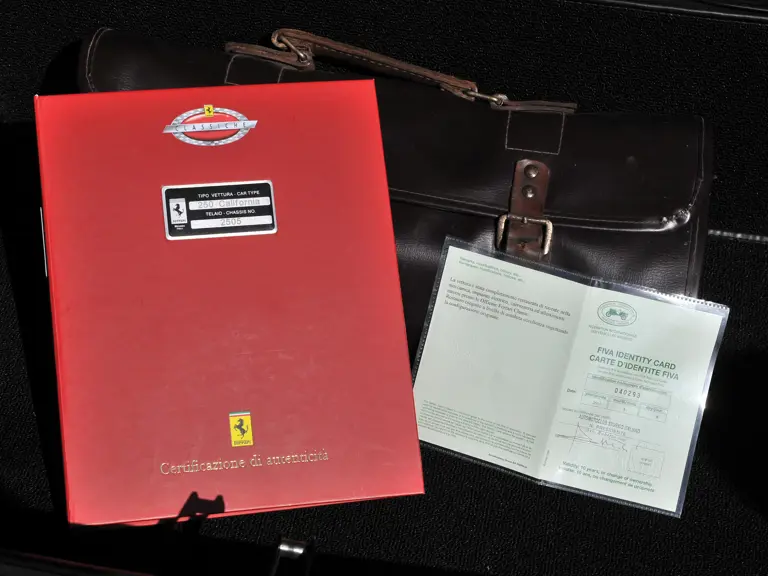

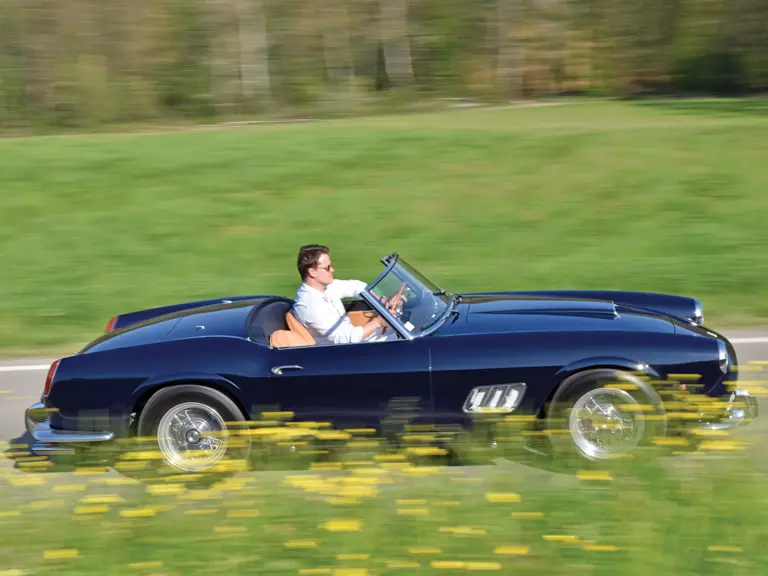



 | Cernobbio, Italy
| Cernobbio, Italy

